Standing as a silent sentinel, the radio tower recedes into the background — thin guy-wires, filigreed steel latticework, and faint lights barely marking space. It is an ethereal architecture — of and on the air. Sometimes in our back yards, sometimes in our urban peripheries, and sometimes along a lone stretch of road between here and there, radio towers describe a diffuse Hertzian landscape of signal and noise, of meaning and its withholding. Sending, receiving, transmitting, collecting — their significance and role not usually announced.
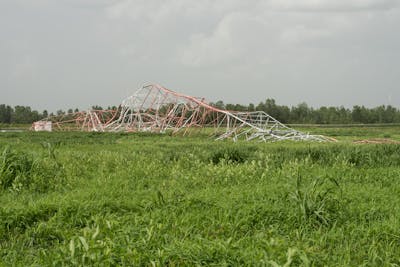
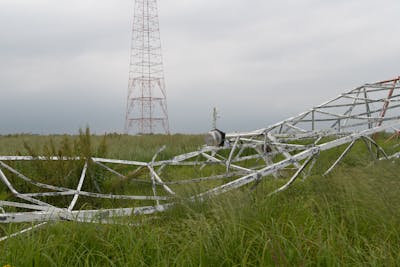
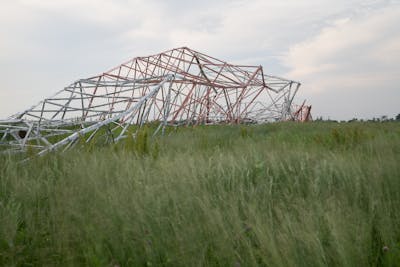
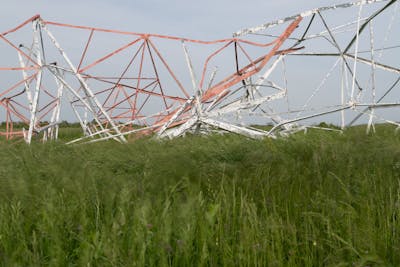
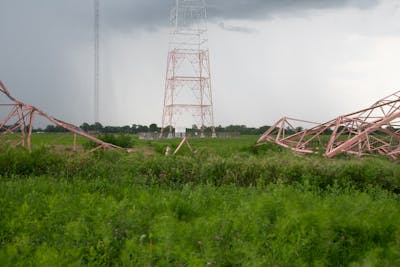
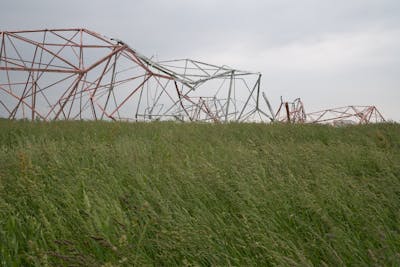
Standing, the tower is one of the few materialities of an otherwise non-visible electromagnetic communication technology — an impossibly high piling-up of material into a latticework of steel and sky. But a radio tower collapsed, fallen to the ground, suddenly jolts us to different forms of awareness: attention to how the vertical tends towards the horizontal; sensitivity to the impossibly delicate members impossibly arranged against gravity; a recollection of other epic failures, maybe even our own. The collapse of a tower operates through both material and symbolic work, not in the overt representational domain of aesthetic symbolism, but rather through a new material production of meaning. Which is to say, only in failure is meaning made.
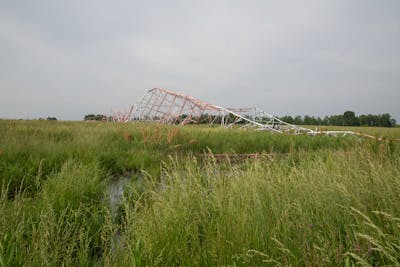
The collapse of tower 4 in the array of radio station KTRS 550 has invited this set of reflections. The structure was 445.5 feet tall, operated at 550 kHz, and was crumpled by an intense microburst on the evening of June 30, 2018. 445.5 feet in the air is different from 445.5 feet on the ground, and the tower lay in repose for almost two years before being hauled away to an adjacent scrap-yard. An abrupt and final material dis-/re-ordering.
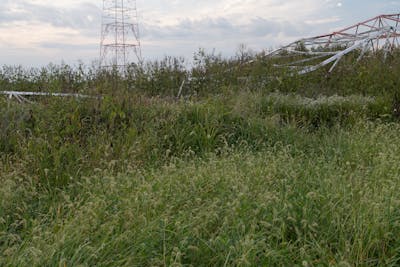
Like all photographic images, those of the fallen tower shared here assume a position between the symbolic and the real. But in the repetition of images, in our return to the same site over as many weeks and seasons as the tower lay in the field, the photographs do something unexpected. The symbolic weight of the first image — which may shock the viewer in its registration of initial violence — is eventually lightened. The series of photographs gradually build an unmarked space that helps us to move again from a symbolic domain back to the real — to a tangle of metal, the spalling red and white paint, the edge between mown and un-mown weeds, a deep divot in the earth.



The presence of a tower of course implies a transmission source, a radio station sending signals: in this instance “The BIG 550.” Its daytime catchment area is one of the largest in the country, spanning six states, and its signal is so strong that the station engineers must turn it down by four-fifths during the nighttime lest it expand to cover half the continent. The tower also suggests an untold number of receivers — a distributed parliament of radio listeners. SUVs, pickup trucks, offices, kitchens, and headphones are all part of the infrastructure sustaining the widely dispersed radio 550 audience — where programs like “Farmer Dave,” “St. Louis in the Know,” “Straight Talk on Retirement,” and “Yard Sale” help us understand the passions, concerns, and anxieties of the listening public.
Antenna engineers call them radiators for the electromagnetic signals they produce. While architects tend to fetishize the structural configuration of steel latticework (such as we find, for example, in the celebrated Shukhov towers), radio tower engineers are most concerned about the much less spectacular properties of insulation and grounding. And when the tower itself is the fundamental radiating unit, material continuity across its many components and discontinuity with the ground are the main priorities. Soft metals slips are inserted between the joints of every connection, ensuring maximum conductivity of the steel frame by distorting and bridging the micro-gaps of bolted steel joints, while the four legs rest on huge nubs of porcelain, reducing the electromagnetic coupling with the ground and forcing a near-zero capacitance at the tower base. Elaborate hinged ladders, interlocking but isolated “O” ring stabilizers, and discontinuous lightning rods are collateral designs that support this energetic architecture of communication.
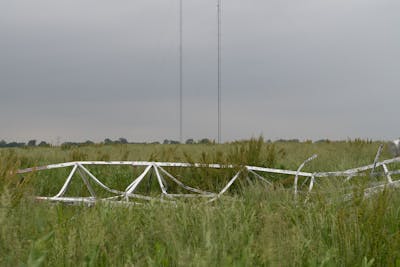
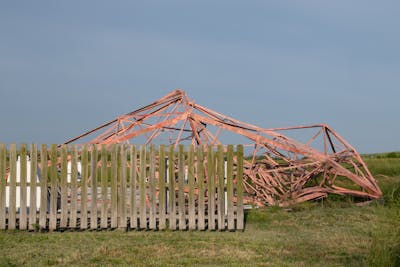
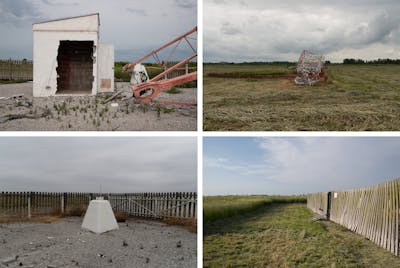
It is perhaps unsurprising that there is a long history of paranoia surrounding radio-waves– any reflection on its ambient saturation cannot help but conjure a kind of electromagnetic sublime. Its waves are simply everywhere. Not only through the thick signal of human infrastructures and sending apparatuses but also through the always and everywhere interaction of the sun and solar wind with the ionosphere of the planet. Given the large wavelengths at which AM radio operates, the earth and the ionosphere form a kind of virtual transmission line, with broadcasters counting on the reflection of signals off the ionosphere to reach across distance, over physical barriers, and around the curvature of the earth — an intense coupling of technology and the planet itself.
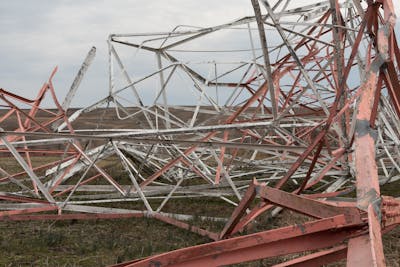
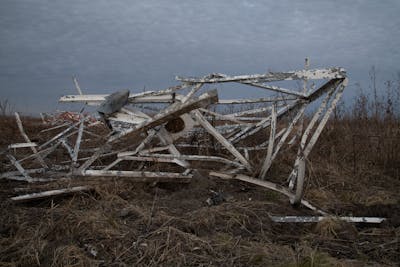
Engineers classify radio waves in three distinct categories — sky waves, space waves, and ground waves — each occupying its own zone in the atmospheric plenum. Radio engineers make their abstract broadcast calculations based on what they call a “perfectly conducting earth” — determining the M.U.F. (“maximum usable frequency”) and the skip distance (a silent interval between where the ground wave dissipates and a reflected wave picks back up). But as most of the earth is in fact of finite conductivity, the signal we hear, and which wave it is carried on, is in general a simple function of our distance from the tower.
There is, of course, a specific geography to radio. AM signals are susceptible to various forms of interference or “static” — caused by both physical obstacles, ambient electromagnetic signals in the atmosphere, and the steel frames of large buildings. So their placement is often in the wide rural spaces adjacent to large cities or on top of prominent high-points.
But this is a geography not only of placement but also of performance — where the electro-physiogeography of the soil itself is incorporated into the transmission apparatus. The wide, flat floodplain where tower 4 stood — an area known locally as The American Bottom — is itself a technical component of the transmission strategy. The unconsolidated alluvium of the saturated bottomland is of high conductivity, thereby boosting the signal and exaggerating the effect of ground waves. What is more, trenched into the ground, and radiating in 120 strands around the tower itself is a ground array the radius of which extends as far horizontally as the tower does vertically. The simple vertical tower is in fact part of a complex four-dimensional assemblage of steel, soil, saturation, and signal. In its collapse, then, this whole landscape of communication is decoupled in a cascading chain of communication failures that link humans, things, media, and places.
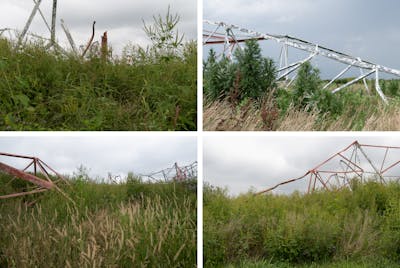
Within this distributed discourse network of senders and receivers, the collapsed tower comes to stand in for a more general principle in the dialectics of communication, the failure to communicate, which Derrida might describe as the impossibility of communication at all. In the signal-to-noise ratios of telecommunications, a collapsed transmitter cancels all signal. In other words, the signal attached to carrier waves is cut off from propagation. We might imagine that the signal itself remains — radio personalities in their booths, announcers reading regional football scores, commercials selling couches — but, for the receiver, it is pure noise.
The meaning of tower 4 changed over time, its singularity of collapse and failure offering only the first of many readings.As the photographs presented here attest, a new habitat formed around the fallen tower. Unable to get too close, for fear of entanglement, the mowing machine operators cut a wide swath around it. A tangle of vines and even a small copse of trees began to grow within its latticework. Where the tower falls, it protects the ground. The fallen tower not as symbolic collapse but as caregiver and shelter. A new type of sentinel of the floodplain ecosystem, where the non-human becomes entangled in the materiality of communication.



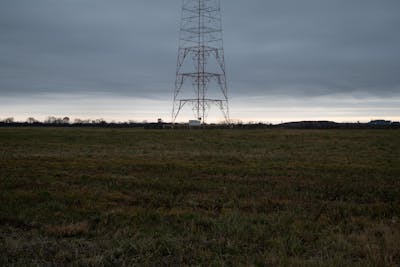
Review
By David L. Hays
“Standard of Repose” is a micro-monumental history of a vague terrain: the American Bottom. By a history of, I mean that it’s both from and about that place — which is perhaps the most credible way to represent a past one cannot grasp without having been there.
Said differently, “Standard of Repose” is a true story (from + about).
Getting to know the American Bottom is a post-occupation preoccupation. Colten and Vogler are part of a constellation of individuals fascinated by that area and committed to sharing their understanding of it with others. They live within it or close by, or they have done so recently. They explore it, alone and together. They observe, take notes, take photos, draw maps. It takes presence over time, they explain, to come to terms with the seemingly disjointed conditions there, in which residuals from “an entire history of North American settlement and aspirations” seem to have settled out scattershot, like fragments of shipwrecks dispersed on an ocean floor. But it isn’t haphazard. “Episodic but not accidental,” I read on the website Charting the American Bottom, a project Vogler co-directs and for which Colten is the photographer. It’s a take that comes from experience.
“Standard of Repose” focuses on one event: the collapse and eventual removal of a radio tower within the American Bottom. It brings together a selection of photographs taken during dozens of site visits and a text interweaving material descriptions and technical data with observations about cultural and geographical contexts. Given my background and interests, I can’t help but see this work in a tradition of portraits of place.1 The opening sequence is topographical; it conveys a sense of presence in a discrete moment, perhaps one of first impression. After that, other ways of knowing and interpreting take over, with speculation, comparison, and memory conspiring to foster imagination.1 Sitting with this work, I feel especially aware of how such compositions draw us in and hold us even as they hold us away. In other words, they are modern. But I want to slip past the velvet rope of critical thinking, not just to get closer to the content but to get inside it, to be part of this past one cannot grasp without having been there, this place that, to be understood, requires presence over time.
Last night, I closed my eyes and tried to imagine being near the radio tower as it collapsed during the sudden storm event on June 30, 2018. The scale and violence of it were beyond what I could imagine.
In his essay “Key Points: Between Figure and Ground” (2016), architectural historian Georges Teyssot draws attention to Simondon’s theory of the “key point,” which Teyssot frames neatly as “a synergetic alliance of technical schemes and natural powers.”2 The idea of engineers as modern magicians, attracted to and engaging sites of natural consequence, seems borne out in the array of KTRS 550 radio towers and how “the electro-physiogeography of the soil itself is incorporated into the transmission apparatus.” But what does it mean, then, when a “key point” comes undone, as in the collapse of tower 4? Or, if a radio tower falls in a field and nobody is tuned in, does it make silence? I wonder which broadcast was cut short, mid-sentence, mid-song, or mid-silence. And I picture a vast choreography of listeners — in homes, workplaces, and vehicles — suddenly reaching out to adjust their dials.
Laid down, the rumpled frame of the tower looks like some massive, long-necked creature — not flesh and bones but an exoskeleton, a molt.
I’m wondering if I can relate to towers the way I relate to trees. Humans have long animated trees through anthropomorphic projection — for example, those ornery specimens in The Wizard of Oz. But the more I learn about trees — how they perceive, communicate, and remember — the more ethereal they seem, even as they are rooted in place.3 If I can relate to trees now, it’s through a growing awareness of my own embodied energies, and that sense also pertains to tower 4 and other radiating structures designed to transmit energy through their frames. That towers are objects, rather than living beings, no longer feels like a limit (per the logic of object-oriented ontology). What matters to me instead is how I am imagining electricity as a tensioner that keeps radiating structures upright, like the sprung threads in a thumb press toy. When the button on the bottom of the toy is pushed, tension is released and the figure slackens. Maybe tower 4 fell because the electricity stopped flowing, if only for a moment. Wouldn’t I do the same?
When I was a child, three weeping willow trees stood at the bottom of our front yard. With their encircling veils of long, thin branches cascading to the ground, they were like vast halls or tents, but from up at the house they looked like elephants. One afternoon, the sky turned black and a violent storm broke out. My brother and I stood on the living room sofa, leaning against its back, and watched through a big picture window. Each time we saw a flash, we would drop down to the seat to wait for the boom of thunder. Suddenly, a bolt of lightning burst in front of us. We shrieked and dropped but also listened intently as the massive clap that shook the house migrated into a strange cracking and crashing. When we surfaced again, the smallest willow tree was on its side.
After the storm had passed, we dashed out to explore. For children who like to climb, a tree on its side is a fresh world of wonders. Intoxicated by the possibilities, I begged my father to leave it, but he wouldn’t, or couldn’t. When I look at the photographs of tower 4 on the ground and the seasons of growth around and inside it, I think of the fallen willow and the impulse to clear it way.
Where I live now, there’s a stick pile in the backyard, something my neighbor started not knowing what else to do with branches that fell from the trees overhead. With time, it has become quite large. To others, it must look like neglect, but various small animals live there, and we like that. Episodic but not accidental.
Notes
Cf. Stephen H. Whiteman, “Access and Intimacy,” in Where Dragon Veins Meet: The Kangxi Emperor and His Estate at Rehe (Seattle, WA: University of Washington Press, 2020), 208 – 224.
Georges Teyssot, “Key Points: Between Figure and Ground,” trans. Alexandre Champagne, reviewed by Robert Mitchell, Forty-Five: A Journal of Outside Research, 24 Jan. 2016: https://forty-five.com/papers/key-points-between-figure-and-ground.
Lindsey french, Echinacea purpurea, Quercus macrocarpa, Asclepias tuberosa, Tsuga canadensis, and Pinus strobus, “land of words: a collection of poetry by plants,” reviewed by David L. Hays, Forty-Five: A Journal of Outside Research, 16 Nov. 2018: https://forty-five.com/papers/land-of-words-a-collection-of-poetry-by-plants.
Biographies
Jennifer Colten’s work focuses on transitional landscapes and the histories of cultural and geographic space. Her photographic practice includes exploration of sites at the margins of the urban environment where resilience and ecological transformation are present. Central concerns consider complex and intertwined issues of social, and environmental implications of land use. Collaboration is essential to Colten’s work where an interdisciplinary approach is part of a larger process of engaging with community, institutions and public space. After receiving her MFA from Massachusetts College of Art in Boston, Colten relocated to the Midwest and can currently be found wandering the American Bottom, where the landscape is shaped by the many forces of the Mississippi River. www.jennifercolten.com Email: jennifer@jennifercolten.com
Jesse Vogler is an architect and artist whose work sits at the intersection of landscape, politics, and performance. His writing and projects address the entanglements between landscape and law and take on themes of work, property, expertise, and memory. Jesse is a MacDowell Fellow, Fulbright Scholar, and, in addition to his art and research practice, he is a land surveyor, co-directs the Institute of Marking and Measuring, and teaches across landscape, architecture, art, and urbanism. He is based in Tbilisi, Georgia, where he is Professor and Head of the Architecture Program at the Free University of Tbilisi. www.jessevogler.com Email: jessevogler@gmail.com
David L. Hays is co-editor of Forty-Five, co-director of the gallery Space p11, founding principal of Analog Media Lab, and Professor and Brenton H. and Jean B. Wadsworth Head of the Department of Landscape Architecture at the University of Illinois at Urbana-Champaign. Trained in architecture and history of art, his scholarly research explores contemporary landscape theory and practice, the history of garden and landscape design in early modern Europe, interfaces between architecture and landscape, and pedagogies of history and design. Hays is the editor of Landscape within Architecture (2004) and (Non-)Essential Knowledge for (New) Architecture (2013), both by 306090/Princeton Architectural Press. His essays have appeared in a wide range of international design- and history-based journals and as chapters in numerous books. Email: dlhays@illinois.edu